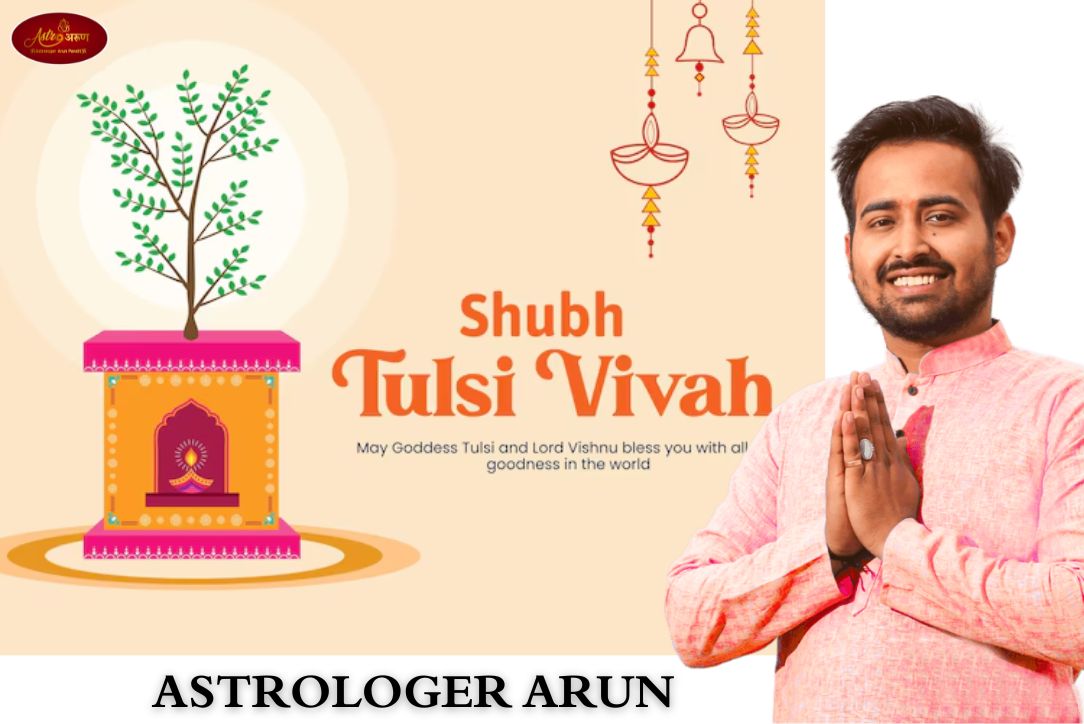Tulsi Vivah is a beautiful Hindu festival that celebrates the divine marriage of Tulsi (the holy basil plant) with Lord Vishnu, represented by Shaligram (a sacred stone). This event marks the end of the four-month period of Chaturmas and the start of the Hindu wedding season. It is a festival that symbolizes devotion, purity, and ecological harmony while honoring marital values.
Mythological Origins of Tulsi Vivah
Tulsi Vivah has its roots in ancient Hindu scriptures and stories:
- Story of Vrinda and Jalandhar: Tulsi, also known as Vrinda, was a devoted wife to the demon king Jalandhar. Her chastity made Jalandhar invincible. To save the world, Lord Vishnu took Jalandhar’s form and broke her vow of chastity. Realizing the truth, Vrinda cursed Vishnu to become a black stone (Shaligram) and immolated herself. From her ashes grew the sacred Tulsi plant, which Vishnu declared as his consort.
- Tulsi as Goddess Lakshmi: Another tale from the Padma Purana narrates that Tulsi was an incarnation of Goddess Lakshmi, cursed to be born as a plant. Lord Vishnu, in his Shaligram form, promised to marry her to reunite with her.
When is Tulsi Vivah Celebrated?
Tulsi Vivah is usually observed on Ekadashi (11th lunar day) of the Shukla Paksha (waxing phase of the moon) in the Hindu month of Kartik (October-November). Some families celebrate it on Dwadashi (12th lunar day). The dates vary annually based on the lunar calendar. In certain regions, the celebrations last from Prabodhini Ekadashi to Kartik Purnima.
Tulsi Vivah Puja Vidhi at Home
Celebrating Tulsi Vivah at home is a joyous and spiritual experience. Follow these steps:
-
Preparations:
- Clean the space where the puja will be held.
- Decorate the Tulsi plant with a saree, jewelry, and a red bindi. Use garlands and bright colors to adorn the area.
- Keep the Shaligram stone ready by bathing it in holy water and dressing it in a dhoti.
-
Setting up the Mandap:
- Create a canopy over the Tulsi plant using sugarcane sticks or colorful fabric.
- Decorate with lamps, flowers, and rangoli to enhance the festive atmosphere.
-
Starting the Puja:
- Light a diya (lamp) and invoke Lord Ganesha for blessings.
- Chant Tulsi and Vishnu mantras while offering flowers and incense.
-
Marriage Rituals:
- Perform aarti for Tulsi and Shaligram.
- Tie a sacred thread around the Tulsi plant and Shaligram, symbolizing their union.
- Offer panchamrit (milk, curd, honey, ghee, and sugar), fruits, and sweets.
- Perform mangalfera by circumambulating the Tulsi plant and Shaligram.
-
Concluding the Puja:
- Distribute prasad to family and neighbors.
- Sing devotional songs and bhajans to end the ceremony on a festive note.
Rituals and Traditions of Tulsi Vivah
The rituals closely mirror a traditional Hindu wedding, including:
- Decorating Tulsi as a Bride: The Tulsi plant is adorned with sarees, ornaments, and flowers, symbolizing a bride.
- Procession of Shaligram: Representing the groom, Shaligram is brought to Tulsi amidst devotional songs and rituals.
- Symbolic Marriage: The priest recites Vedic mantras as the marriage is performed. Circumambulation and tying of the sacred thread seal the union.
- Community Feasts: Devotees prepare sweets and traditional dishes to distribute as prasad, fostering unity.
Significance of Tulsi Vivah
Tulsi Vivah holds deep spiritual and cultural meanings:
- Blessings and Prosperity: Performing the ritual is believed to bring marital harmony and good fortune.
- Ecological Symbolism: Tulsi’s medicinal and environmental benefits highlight nature’s divinity.
- Social Value: It provides an affordable way for devotees to conduct a symbolic wedding.
Cultural Celebrations Across India
The festival is celebrated differently across regions:
- North India: Tulsi Vivah is marked by vibrant processions and elaborate rituals at temples and homes.
- Maharashtra: Women sing traditional songs while performing Tulsi puja with devotion.
- South India: Families organize pujas, emphasizing Tulsi’s agricultural and spiritual importance.
- West Bengal: The festival coincides with Kartik Purnima and includes ecological themes.
Environmental and Spiritual Symbolism
Tulsi is not only a sacred plant but also a symbol of environmental conservation. By honoring Tulsi, we emphasize the importance of ecological balance. Many communities promote plantation drives and eco-friendly practices during Tulsi Vivah to spread awareness.
Modern-Day Relevance of Tulsi Vivah
In today’s fast-paced world, Tulsi Vivah continues to be a meaningful tradition. Families adapt the rituals to modern lifestyles, ensuring the cultural essence remains intact. The festival fosters togetherness and promotes values of devotion and harmony. Additionally, environmentalists leverage the occasion to highlight Tulsi’s role in combating pollution and promoting health.
Conclusion
Tulsi Vivah is more than just a ritual; it is a celebration of faith, nature, and the sacred bond of marriage. It connects mythology with environmental consciousness, offering lessons that resonate deeply with modern values. By preserving and celebrating this tradition, we honor our roots while fostering a sense of unity with the divine and nature.
FAQs
1. What is Tulsi Vivah?
Tulsi Vivah is a Hindu festival that celebrates the symbolic marriage of Tulsi (the holy basil plant) with Lord Vishnu, represented by the Shaligram stone. It marks the end of the Chaturmas period and the beginning of the Hindu wedding season.
2. Why is Tulsi Vivah celebrated?
Tulsi Vivah is celebrated to honor the divine relationship between Tulsi and Lord Vishnu. The ritual symbolizes devotion, purity, and the sanctity of marriage. It is also believed to bring prosperity, marital harmony, and blessings to those who observe it.
3. When is Tulsi Vivah celebrated?
Tulsi Vivah is observed on the Ekadashi (11th lunar day) or Dwadashi (12th lunar day) of the Shukla Paksha (waxing phase of the moon) in the Hindu month of Kartik, which usually falls in October or November. The exact date varies each year based on the lunar calendar.
4. What is the significance of Tulsi in Hinduism?
Tulsi is considered a sacred plant in Hinduism, often referred to as “Holy Basil.” It is revered for its spiritual, medicinal, and ecological importance. Tulsi is believed to purify the mind, body, and surroundings, and it is worshipped as an incarnation of Goddess Lakshmi.
5. How is Tulsi Vivah performed at home?
To perform Tulsi Vivah at home, devotees:
- Clean and decorate the Tulsi plant as a bride, adorning it with a saree, jewelry, and flowers.
- Prepare the Shaligram stone, symbolizing the groom, by bathing it and dressing it in a dhoti.
- Set up a wedding mandap with decorations and perform the marriage rituals, including tying a sacred thread and offering prasad.
6. Can unmarried people perform Tulsi Vivah?
Yes, unmarried people can perform Tulsi Vivah. It is believed to help them find a suitable life partner and bless their future married life with harmony and prosperity.
7. What items are required for Tulsi Vivah Puja?
The essential items for Tulsi Vivah Puja include:
- A Tulsi plant.
- Shaligram stone.
- Saree and jewelry for the Tulsi plant.
- Flowers, garlands, and lamps.
- Panchamrit (a mixture of milk, curd, honey, ghee, and sugar).
- Fruits, sweets, and other offerings.
8. What is the story behind Tulsi Vivah?
The mythological origins of Tulsi Vivah involve the story of Vrinda, a devoted wife of the demon king Jalandhar. After her chastity was broken by Lord Vishnu, Vrinda cursed him to become a black stone (Shaligram) and immolated herself. From her ashes grew the sacred Tulsi plant. Lord Vishnu declared Tulsi as his consort to honor her devotion.
9. Is Tulsi Vivah celebrated differently in various regions of India?
Yes, Tulsi Vivah is celebrated with regional variations across India:
- North India: Vibrant processions and elaborate rituals at temples and homes.
- Maharashtra: Women sing traditional songs while performing Tulsi puja.
- South India: Rituals focus on the agricultural and spiritual significance of Tulsi.
- West Bengal: The festival coincides with Kartik Purnima and promotes ecological awareness.
10. What is the ecological significance of Tulsi Vivah?
Tulsi Vivah highlights the importance of environmental conservation. The festival encourages planting Tulsi, which is known for its medicinal properties and ability to purify the air. It serves as a reminder of the sacred bond between humans and nature.
11. What are the benefits of observing Tulsi Vivah?
Observing Tulsi Vivah is believed to:
- Bring peace, prosperity, and harmony to families.
- Strengthen marital relationships.
- Provide spiritual growth and divine blessings.
- Promote ecological awareness and encourage sustainable living.
12. How does Tulsi Vivah influence the wedding season?
Tulsi Vivah marks the end of the Chaturmas period, a time considered inauspicious for Hindu weddings. With this festival, the auspicious season for marriages begins.
13. Is Tulsi Vivah mentioned in Hindu scriptures?
Yes, Tulsi Vivah is mentioned in texts like the Padma Purana and Skanda Purana. These scriptures narrate the stories of Tulsi’s origins and her marriage to Lord Vishnu, emphasizing her spiritual significance.
14. Can Tulsi Vivah be celebrated in temples?
Yes, many Hindu temples organize grand celebrations of Tulsi Vivah. Devotees gather to witness the rituals, listen to Vedic chants, and participate in processions, making it a community event.
15. What modern practices are associated with Tulsi Vivah?
In modern times, Tulsi Vivah is celebrated with adaptations to suit contemporary lifestyles. Many people organize eco-friendly rituals, promote Tulsi plantation drives, and use the occasion to raise awareness about environmental issues.
Related Blog: Rules of Wearing Tulsi Mala








